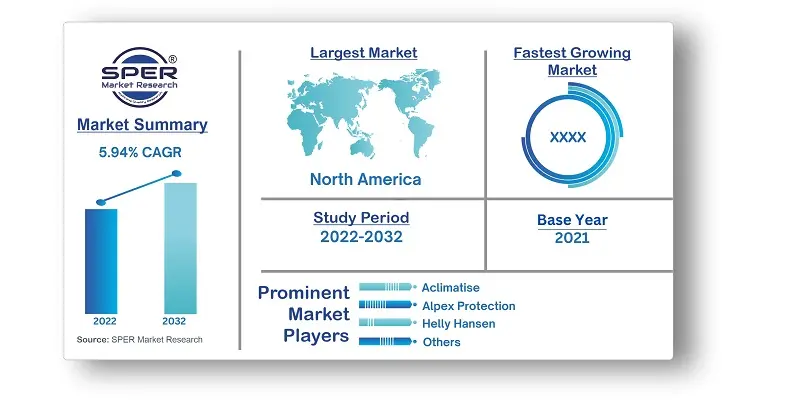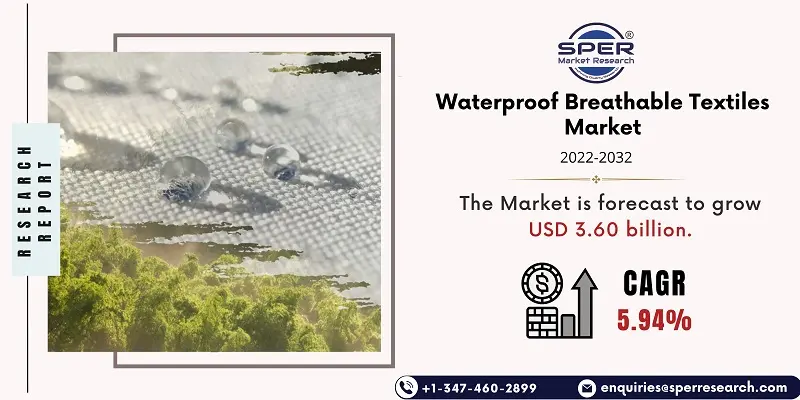
Waterproof Breathable Textiles Market Growth, Size, Trends, Demand, Revenue and Future Outlook
Waterproof Breathable Textiles Market Size- - By Product Type, By Fabric Type, By Application -Regional Outlook, Competitive Strategies and Segment Forecast to 2032
| Published: Dec-2022 | Report ID: CHEM2216 | Pages: 1 - 234 | Formats*: |
| Category : Chemical & Materials | |||
- In July 2021, Derekduck Industries Corp. enhanced its ULTITEX line in July 2021 with the addition of ULTITEC 1800 and ULTITEC 2000 sticky storm flaps. This launch emphasizes the company's dedication to innovation in protective textiles, improving products for diverse industries and contributing to improvements in the waterproof breathable textiles (WBT) market.
- In December 2020, The North Face, an American outdoor recreation clothing manufacturer, worked with Gucci, an Italian luxury brand, to create a trendy collection of hiking gear. The line contains clothes and accessories that are both fashionable and functional, such as climbing gear-inspired backpacks, belt bags, tents, sleeping bags, hiking boots, beanies, shirts, and coats.


| Report Metric | Details |
| Market size available for years | 2019-2032 |
| Base year considered | 2021 |
| Forecast period | 2022-2032 |
| Segments covered | By Product Type, By Fabric Type, By Application |
| Regions covered | North America, Asia-Pacific, Latin America, Middle East & Africa and Europe |
| Companies Covered | Aclimatise, Alpex Protection, Helly Hansen, HeiQ Materials, Jack Wolfskin Retail GmbH, Marmot Mountain LLC, Mountain Hardwear, Nextec Applications, Schoeller Switzerland. |
- Service Providers/ Buyers
- Industry Investors/Investment Bankers
- Education & Research Institutes
- Research Professionals
- Emerging Companies
- Manufacturers
- Sportswear Brands
- Outdoor Gear Manufacturers
- Government and Defense
| By Product Type: |
|
| By Fabric Type: |
|
| By Application: |
|
- Global Waterproof Breathable Textiles Market Size (FY’2022-FY’2032)
- Overview of Global Waterproof Breathable Textiles Market
- Segmentation of Global Waterproof Breathable Textiles Market By Product Type (ePTFE, Polyurethane, Polyester, Others)
- Segmentation of Global Waterproof Breathable Textiles Market By Fabric Type (Densely Woven, Membrane, Coated)
- Segmentation of Global Waterproof Breathable Textiles Market By Application (General Clothing & Accessories, Sports Goods, Protective Clothing, Others)
- Statistical Snap of Global Waterproof Breathable Textiles Market
- Expansion Analysis of Global Waterproof Breathable Textiles Market
- Problems and Obstacles in Global Waterproof Breathable Textiles Market
- Competitive Landscape in the Global Waterproof Breathable Textiles Market
- Impact of COVID-19 and Demonetization on Global Waterproof Breathable Textiles Market
- Details on Current Investment in Global Waterproof Breathable Textiles Market
- Competitive Analysis of Global Waterproof Breathable Textiles Market
- Prominent Players in the Global Waterproof Breathable Textiles Market
- SWOT Analysis of Global Waterproof Breathable Textiles Market
- Global Waterproof Breathable Textiles Market Future Outlook and Projections (FY’2022-FY’2032)
- Recommendations from Analyst
1.1. Scope of the report1.2. Market segment analysis
2.1. Research data source2.1.1. Secondary Data2.1.2. Primary Data2.1.3. SPER’s internal database2.1.4. Premium insight from KOL’s2.2. Market size estimation2.2.1. Top-down and Bottom-up approach2.3. Data triangulation
4.1. Driver, Restraint, Opportunity and Challenges analysis4.1.1. Drivers4.1.2. Restraints4.1.3. Opportunities4.1.4. Challenges4.2. COVID-19 Impacts of the Global Waterproof Breathable Textiles Market
5.1. SWOT Analysis5.1.1. Strengths5.1.2. Weaknesses5.1.3. Opportunities5.1.4. Threats5.2. PESTEL Analysis5.2.1. Political Landscape5.2.2. Economic Landscape5.2.3. Social Landscape5.2.4. Technological Landscape5.2.5. Environmental Landscape5.2.6. Legal Landscape5.3. PORTER’s Five Forces5.3.1. Bargaining power of suppliers5.3.2. Bargaining power of buyers5.3.3. Threat of Substitute5.3.4. Threat of new entrant5.3.5. Competitive rivalry5.4. Heat Map Analysis
6.1. Global Waterproof Breathable Textiles Market Manufacturing Base Distribution, Sales Area, Product Type6.2. Mergers & Acquisitions, Partnerships, Product Launch, and Collaboration in Global Waterproof Breathable Textiles Market
7.1. Global Waterproof Breathable Textiles Market Size Share and Forecast, By Product Type, 2019-20257.2. Global Waterproof Breathable Textiles Market Size Share and Forecast, By Product Type, 2026-20327.3. ePTFE7.4. Polyurethane7.5. Polyester7.6. Others
8.1. Global Waterproof Breathable Textiles Market Size Share and Forecast, By Fabric Type, 2019-20258.2. Global Waterproof Breathable Textiles Market Size Share and Forecast, By Fabric Type, 2026-20328.3. Densely Woven8.4. Membrane8.5. Coated
9.1. Global Waterproof Breathable Textiles Market Size Share and Forecast, By Application, 2019-20259.2. Global Waterproof Breathable Textiles Market Size Share and Forecast, By Application, 2026-20329.3. General Clothing & Accessories9.4. Sports Goods9.5. Protective Clothing9.6. Others
10.1. Global Waterproof Breathable Textiles Market Size and Market Share
11.1. Global Waterproof Breathable Textiles Market Size and Market Share By Region (2019-2025)11.2. Global Waterproof Breathable Textiles Market Size and Market Share By Region (2026-2032)11.3. Asia-Pacific11.3.1. Australia11.3.2. China11.3.3. India11.3.4. Japan11.3.5. South Korea11.3.6. Rest of Asia-Pacific11.4. Europe11.4.1. France11.4.2. Germany11.4.3. Italy11.4.4. Spain11.4.5. United Kingdom11.4.6. Rest of Europe11.5. Middle East and Africa11.5.1. Kingdom of Saudi Arabia11.5.2. United Arab Emirates11.5.3. Qatar11.5.4. South Africa11.5.5. Egypt11.5.6. Morocco11.5.7. Nigeria11.5.8. Rest of Middle East & Africa11.6. North America11.6.1. Canada11.6.2. Mexico11.6.3. United States11.7. Latin America11.7.1. Argentina11.7.2. Brazil11.7.3. Rest of Latin America
12.1. Aclimatise12.1.1. Company details12.1.2. Financial outlook12.1.3. Product summary12.1.4. Recent developments12.2. Alpex Protection12.2.1. Company details12.2.2. Financial outlook12.2.3. Product summary12.2.4. Recent developments12.3. Helly Hansen12.3.1. Company details12.3.2. Financial outlook12.3.3. Product summary12.3.4. Recent developments12.4. HeiQ Materials12.4.1. Company details12.4.2. Financial outlook12.4.3. Product summary12.4.4. Recent developments12.5. Jack Wolfskin Retail GmbH12.5.1. Company details12.5.2. Financial outlook12.5.3. Product summary12.5.4. Recent developments12.6. Marmot Mountain LLC12.6.1. Company details12.6.2. Financial outlook12.6.3. Product summary12.6.4. Recent developments12.7. Mountain Hardwear12.7.1. Company details12.7.2. Financial outlook12.7.3. Product summary12.7.4. Recent developments12.8. Nextec Applications12.8.1. Company details12.8.2. Financial outlook12.8.3. Product summary12.8.4. Recent developments12.9. Schoeller Switzerland12.9.1. Company details12.9.2. Financial outlook12.9.3. Product summary12.9.4. Recent developments12.10. Others
SPER Market Research’s methodology uses great emphasis on primary research to ensure that the market intelligence insights are up to date, reliable and accurate. Primary interviews are done with players involved in each phase of a supply chain to analyze the market forecasting. The secondary research method is used to help you fully understand how the future markets and the spending patterns look likes.
The report is based on in-depth qualitative and quantitative analysis of the Product Market. The quantitative analysis involves the application of various projection and sampling techniques. The qualitative analysis involves primary interviews, surveys, and vendor briefings. The data gathered as a result of these processes are validated through experts opinion. Our research methodology entails an ideal mixture of primary and secondary initiatives.



Frequently Asked Questions About This Report
PLACE AN ORDER
Year End Discount
Sample Report
Pre-Purchase Inquiry
NEED CUSTOMIZATION?
Request CustomizationCALL OR EMAIL US
100% Secure Payment






Related Reports
Our Global Clients
Our data-driven insights have influenced the strategy of 200+ reputed companies across the globe.




















